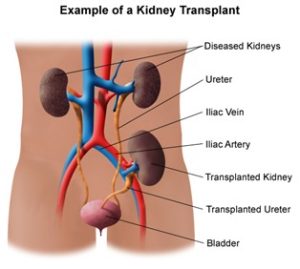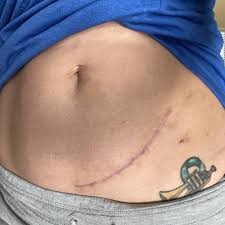What is a kidney transplant?
Keep track of your kidney data with PKB
Key Points
- A kidney transplant is the best treatment for CKD5 (kidney failure) for many people
- The kidney can come from a live donor (friend, relative or partner) or deceased (dead) donor
- Kidneys from live donors last approximately 15 years and kidneys from deceased donors last, on average, for 10 years
- You may need 2 or more transplants in your CKD5 journey
- Never run out of immunosuppressive tablets.
We will now describe what is a kidney transplant. Let’s start with the basics.
1. Introduction
A kidney transplant is a surgical procedure in which a patient with kidney failure (CKD Stage 5) receives a new kidney from either a living donor or a deceased (dead) donor. The two original kidneys usually remain in place, and the donor kidney is placed in the lower abdomen in addition to the two original kidneys.

Where a kidney transplant is placed
A kidney transplant is not a cure, but the best treatment for many people with kidney failure.
2. Where do the kidneys come from?
The donated kidney may be from an alive donor (living) or dead (deceased)
- Living related donor – someone who is alive and who is related to the person receiving the transplant, such as a parent, sibling, or child
- Living unrelated donor – someone who is alive such as a friend, spouse or anonymous (unknown identity)
- Deceased donor – a person who has recently died and who has no known chronic kidney disease.
There is more about the pros and cons of the different types of transplant below.
3. How does a kidney transplant compare to dialysis treatment?
A kidney transplant has many advantages over dialysis. It can treat your kidney failure, improve your health, and provide you with a lifestyle free from dialysis. You will have fewer fluid and diet restrictions, often able to eat and drink what you like. Most people feel well enough to work, or go to school or university. Sex life improves too.
Also. If you have a successful kidney transplant, you may live a longer life than you would have whilst on dialysis.
With transplantation comes responsibilities. For your new kidney to work, you must take medication every day. This medication can have side effects. You may also have complications, such as rejection of your new kidney or infections. Each patient responds differently to a kidney transplant. More about complications later.
4. Who is eligible for a kidney transplant?
There is no specific age limit for a transplant. It depends on the ‘fitness’ of the patient ( how ‘well’ the patient is, any significant existing medical conditions, would they be suitable for surgery).
However, after the age of 70, there may not be any benefit made to the length of life of these patients if they had a transplant at this point. Though improving quality of life (QoL) is important in older patients as well.
If the kidney does not work or if there are complications after transplant, QoL may be worse after a transplant.
5. How do I find out if I am eligible (and what is a transplant ‘work-up’)?
There are many steps to determining if you are eligible for a kidney transplant. This process is called a ‘transplant workup’ and usually takes about 6 months. So it’s best to start it early – at the CKD4 stage, i.e. eGFR 15-30 mls/min, with a blood creatinine 250-300 mcmol/L.
Your kidney doctor (nephrologist) will refer you to the transplant team to start this process. It involves meeting with several members of the transplant team, and lots of blood tests and x-rays, to make sure you are a good candidate.
Your nephrologist will work closely with the specialist nurses (transplant co-ordinators) and your surgeon, to complete your medical evaluation; including making sure you have all the necessary tests, which will allow them to match a kidney to you. The final decision is made by a combination of these professionals discussing your case in a group meeting called a MDT (multi-disciplinary team).
You may also need an echocardiogram (ECHO; sound picture of the heart) and/or see a heart specialist (cardiologist) – to make sure your heart is healthy enough to go through surgery.
6. Waiting for the transplant
Once all the test results are reviewed by the transplant team – and if they have cleared you for a transplant – you will be placed on the ‘active waiting list’. The average wait for a deceased donor kidney transplant in the UK is about 18 months; with most people transplanted by 3 years on the waiting list.
But it can be 3 days or 30 years, or never. It is not really a waiting list, i.e. ‘first in, first out’. We wait until the kidney best suited to you becomes available.
To remain active, a blood sample (for ’tissue typing’) needs to be sent off every three months. Tissue typing is a process where the blood from the patient awaiting a transplant is checked with the donor patient’s blood type to see if they would be suitable. This is coordinated through your dialysis centre or nephrologist (kidney doctor).
A living transplant can be done at any time. So there is no significant wait. This is another one of their major advantages.
7. Types of kidney transplant, and kidney survival
There are two types of kidney transplants: those from a living donor, and those from a deceased donor.
Living donor
A living donor kidney comes from a healthy adult. Living donors can be family members, friends, or anonymous (unknown identity). When a person volunteers to be a potential living donor, they have to have blood tests to find out if they are a good donor for the recipient. Once compatibility (if they are a suitable donor match) is confirmed, living donors must also have additional testing to make sure their kidneys are healthy and that they are in good enough health to be a donor.

A living kidney donor and recipient – bonded forever
Statistics show that kidney transplants from live donors function longer, with a kidney survival rate of more than 95% for the first year – i.e. 1 in 20 kidney transplants do not work at one year after the transplant took place. The average life of a kidney from a living donor is 15-20 years. So younger patients may need more than one transplant in their life. No live donor candidate is allowed to donate a kidney unless the transplant team is certain, to the best of their ability, that the donor will live a normal, healthy life with one kidney.
Deceased donor
A deceased donor kidney comes from a person who has chosen to be an organ donor, and has been declared deceased. Like the living donor, the deceased donor must have blood testing performed to show compatibility (suitability to match) with the proposed recipient. The kidney survival rate for deceased donor kidneys is more than 85% for the first year – i.e. 3 in 20 kidney transplants are not working at one year after the kidney is transplanted. The average life of a kidney from a deceased donor is about 10-15 years.
Being contactable
It is your responsibility to let the team know if you move, or change any phone number. If you move or are going away, please let your coordinator know ahead of time. It is important to remain contactable at all times, in case a kidney becomes available. If we cannot contact you easily, it will be given to someone else – and there could be a long wait for the next one.
So that is where they come from. But what is a kidney transplant?
8. The operation
You only need one working kidney to be healthy, so only one kidney is transplanted during surgery. In fact 1 in 1000 people are born with one kidney, and they are fine.
During the transplant, your two original kidneys usually remain in place and the new donor kidney will placed, in addition, into your lower abdomen. The operation usually takes 2-3 hours. The donor kidney ureter (urine tube) will then be attached to your bladder (see diagram below).
If the kidney transplant surgery is successful, your new kidney will rapidly take over the tasks of filtering your blood and making urine, just like your own kidneys did before you had CKD.

9. After the transplant
You will need to stay in the hospital for about 7 days after the operation. After discharge from hospital, you will need close follow-up by the transplant team and very regular blood tests for 6 months. Blood tests can be three times per week initially, then if all blood tests are stable, they can be reduced to twice weekly and then once a week. They will eventually become less and less frequent.
If things are not stable, you may need to be seen daily, and may even be readmitted to hospital – e.g. for a transplant kidney biopsy if the doctors think rejection may be happening. Rejection is when the the immune system of the patient who has received the transplanted kidney attacks the new kidney. This can make the patient very unwell and may cause the new kidney to stop working.
You will need to have regular check-ups with blood tests for the rest of your life.
The first year
Is very important. A ‘good kidney’ is one that is working well after one year; say with a blood creatinine of under 150 mcmol/L, ideally 120 mcmol/L or less (normal kidney function) – having had no major complications.
 Typical kidney transplant scar
Typical kidney transplant scar
10. Complications
Early complications
As with any surgery, there may be issues and complications. Potential risks after kidney transplant surgery include:
- Bleeding
- Blockage of transplant renal artery or vein (with a blood clot)
- Rapid loss of the kidney – requiring transplant removal (nephrectomy)
- Temporary lack of kidney function. Your new kidney may not start working immediately and you may need dialysis until it resumes normal kidney function. This occurs in up to 30% of deceased donor transplants, less often in living transplants
- Organ rejection. Your body may reject the donor organ and you may need extra medication to help your body accept the new kidney. Rejection is most likely in the first year, especially the first three months.
Later complications
- Blood clots. These occur in the lower legs and lungs, usually in the first month after the operation
- Heart attack or stroke. A transplant puts you at a higher risk than a healthy person who has not had a transplant, especially if you have high blood pressure, high cholesterol or diabetes
- Narrowing of the artery leading to the kidney – also called transplant artery stenosis. This can show itself as worsening kidney function and/or very high blood pressure
- Transplant failure. Your new kidney may fail after a number of years and you may need to have a second (or third) transplant, or go back on dialysis.
Complications of immunosuppressant drugs
Immunosuppressants are a medication which prevent your body’s immune system from attacking the new kidney, which would cause the transplanted kidney to be rejected. A combination of 2 or 3 different immunosuppressants – including prednisolone, azathioprine, mycophenolate, ciclosporin and tacrolimus – are usually taken long term.
These drugs can cause a wide range of side effects, including:
- Increased risk of infection
- Increased risk of diabetes (30% of those on tacrolimus – yes, a very high risk)
- High blood pressure
- Weight gain
- Abdominal pain or diarrhoea
- Extra hair growth or hair loss (ciclosporin and tacrolimus respectively)
- Swollen gums (ciclosporin)
- Bruising or bleeding more easily
- Thinning of the bones
- Acne
- Mood swings
- Increased risk of certain types of cancer; particularly skin cancer, and lymphoma (2%, with 80% of those happening in the first two years).
Your doctors will try to find the right dose that is high enough to ‘dampen’ the immune system to stop rejection, but low enough that you experience few or no side effects.
Finding the optimal dose to achieve both goals is often a difficult balancing act. It may take several months to find the most effective dose that causes the least amount of side effects.
Side effects should improve once the right dosage is identified.
“Even if your side effects become troublesome, never suddenly stop taking your medicine.”
If you do this, your kidney could be rejected, causing permanent loss of your kidney in 48-72 hours. So never run out of tablets. If you think you are about to run out of medications, go to your kidney unit any day of the week or weekend.
Summary
We have described what is a kidney transplant. We hope you understand them better now.
Other resource
Renal transplantation (UHCW patient information)
Top Tip
Never run out of tablets. That’s it.
https://www.youtube.com/watch?v=SKEwxQrfzPQ
Last Reviewed on 4 May 2024
